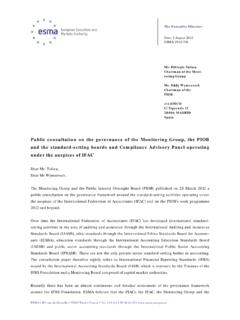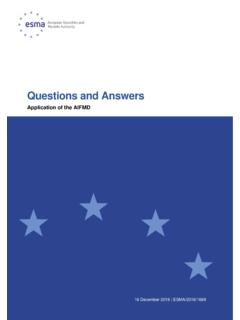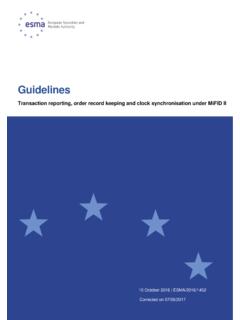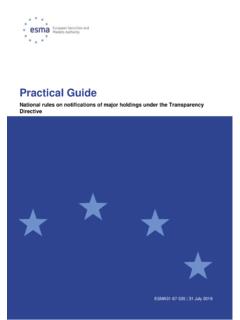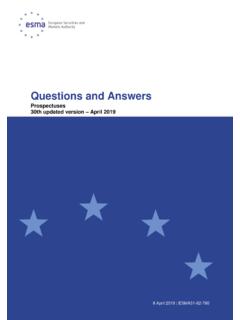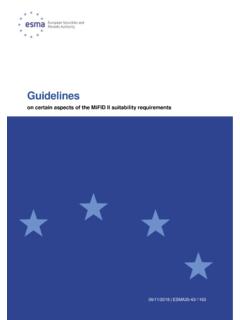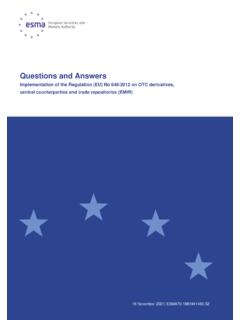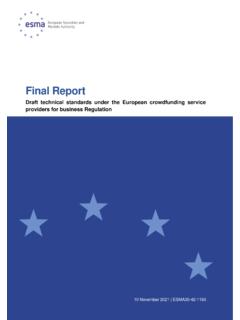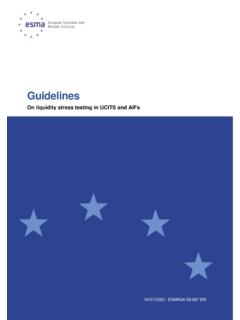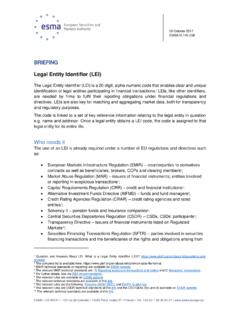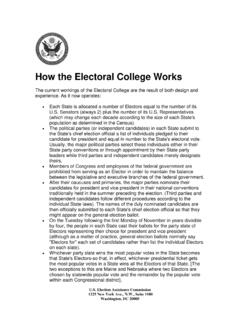Transcription of Preliminary report
1 15 November 2021 | ESMA70-445-7 Preliminary report Emission Allowances and derivatives thereof ESMA 201-203 rue de Bercy CS 80910 75589 Paris Cedex 12 France Tel. +33 (0) 1 58 36 43 21 2 15 November 2021 ESMA 70-445-7 3 Table of Contents 1 Executive Summary .. 4 2 Introduction .. 6 3 Carbon markets and the regulatory environment in securities supervision .. 8 Carbon markets under MiFID II/MiFIR .. 8 Financial Instruments .. 8 Transaction reports .. 9 Weekly and daily position reports .. 13 Transparency data .. 14 Orderly trading .. 14 Carbon markets under MAR .. 15 Carbon markets under EMIR .. 18 Details of derivatives reported to the TRs .. 19 Reports made available by the TRs to the authorities .. 20 Public data .. 21 Revised technical standards under EMIR REFIT.
2 21 4 Recent market developments .. 22 Evolution of carbon market price and volatility .. 22 Spot prices .. 22 Forward curve .. 25 Volatility .. 27 Comparison with other assets .. 30 Evolution of open positions and counterparties in the EU carbon market based on weekly position reports .. 33 Data availability .. 33 Classification of counterparties .. 33 Analysis .. 34 5 Next steps .. 38 6 Annexes .. 40 Annex 1 .. 40 4 1 Executive Summary Reasons for publication The European Trading Scheme (ETS) is a key tool of the EU policy against climate change. It puts a price on the CO2 that entities subject to compliance obligations can release to the atmosphere, with the overall objective of reducing net greenhouse gas emissions. In its Communication on Energy Prices Tackling rising energy prices: a toolbox for action and support , published on 13 October 2021, the European Commission highlights that questions have emerged around the functioning of the European carbon market.
3 In order to examine more closely patterns of trading behaviours and the potential need for targeted actions, the Commission asks ESMA for a first Preliminary assessment of European carbon markets by 15 November and tasks it to analyse, by early 2022, the trading of emission allowances (EUA). This report presents the Preliminary assessment of carbon markets and derivatives thereof. Content Following an introduction (Section 2) where ESMA describes the mandate received as well as the functioning of the primary and secondary markets on emission allowances, the report is structured as follows: Section 3 presents the regulatory environment for the EU carbon market under financial regulations such as MiFID II/MiFIR, MAR and EMIR. Indeed, since 2018, emission allowances are financial instruments and hence subject to a series of requirements aiming at ensuring the transparency and the integrity of this market.
4 This section describes in particular regulatory requirements related to the information that national securities supervisors obtain from entities trading in emission allowances and their derivatives. Section 4 presents a Preliminary assessment of recent market developments in the carbon market, based on data available at short notice. Firstly, ESMA has assessed the price evolution of EUA and derivatives thereof as well as their volatility, on the basis of commercial data. This assessment shows that EUAs have more in common with energy commodities than with other traditional financial instruments, such as shares or bonds. Secondly, ESMA has used data available from weekly position reporting to assess the evolution of the number of market participants and their open positions in carbon markets.
5 This assessment shows that the number of counterparties holding a position on EUA futures has tended to increase since 2018 in all categories of counterparties, in relatively homogeneous proportions. This is in line with the observed expansion of the EU ETS markets. Furthermore, open positions are to a large extent in the hands of investment firms (40% to 47% depending on the period considered) and non-financial counterparties (45% to 50%), hence the remaining percentage of open positions, held by investment funds and other financial counterparties, remains low (around 8% recently). The breakdown of open positions between the various categories of counterparties does not appear to have significantly changed since 2018 and is broadly in line with the expected functioning of the 5 market, whereby non-financial entities buy EUA futures to hedge their carbon price exposure while financial counterparties act as intermediaries to facilitate trading and provide liquidity to the market.
6 Next Steps Following this Preliminary report , according to the mandate given to ESMA by the Commission, ESMA will produce, by early 2022, a report analysing the trading of emission allowances. In order to do so, ESMA intends to deepen its analysis of the EU carbon market based on the regulatory data available under the applicable MiFID II and EMIR requirements. This will allow the Commission to assess whether certain trading behaviours would require further regulatory actions. 6 2 Introduction 1. On 13 October 2021, the European Commission adopted a Communication on Energy Prices , to help tackle the exceptional rise in global energy prices, which is projected to last through the winter, and help Europe's people and businesses. The Communication includes a toolbox that the EU and its Member States can use to address the immediate impact of current prices increases and identifies actions for strengthening resilience against future shocks.
7 2. One of the measures put forward by the European Commission in this Communication is to step up market surveillance of energy markets, including of the European carbon market. In this respect, the European Commission has asked ESMA to further enhance the monitoring of developments in the European carbon market as follows: To examine more closely patterns of trading behaviours and the potential need for targeted actions, the Commission will ask ESMA, for a first Preliminary assessment by 15 November and task it to analyse, by early 2022, the trading of emission allowances. The Commission will consequently assess whether certain trading behaviours would require further regulatory actions. 3. The primary market for emission allowances consists of auctions to which, in addition to compliance entities1, most categories of market participants are able to participate in ( credit institutions, investment firms, funds, commodity trading firms without compliance requirements), provided that as bidders they meet the relevant admission requirements as set out in the Auctioning Regulation 1031/20102 (Articles 18 and 19) which guarantees a fair and open access for all auction participants.
8 The admission requirements of the Auctioning Regulation require, among others, all the entities that are not compliance buyers to be established in the EU, the opening of an account in the Union registry3, appointing of at least one bidder s representative, existence of technical arrangements but also compliance with the admission requirements of the auction platforms ( evidence of personal reliability and professional qualification, recognition as a trading participant by the clearing house). 4. In the EU, most4 Member States have jointly procured the German regulated market EEX as the common platform to auction the allowances under the European Emissions Trading System (EU ETS) defined in the ETS Directive5. Separate auctions are organised by EEX on behalf of Germany and 1 Companies and aircraft operators who are obliged to participate in the EU ETS.
9 2 Commission Regulation (EU) No 1031/2010 on the timing, administration and other aspects of auctioning of greenhouse gas emission allowances 3 The Union Registry serves to guarantee accurate accounting for all allowances issued under the EU emissions trading system (EU ETS). The registry keeps track of the ownership of allowances held in electronic accounts. 4 Germany and Poland have an opt-out clause. 5 Directive 2003/87/EC of the European Parliament and of the Council of 13 October 2003 establishing a system for greenhouse gas emission allowance trading within the Union and amending Council Directive 96/61/EC 6 EEX will also organise the auctions of the allowances belonging to the UK, since the EU ETS Directive continues to apply to and in the UK in respect of the generation of electricity in Northern Ireland, on the basis of the Protocol on Ireland/Northern Ireland.
10 7 5. EEX auctions two types of allowances: EU allowances (EUA) and EU aviation allowances (EUAA). The auctions take place on a daily basis according to a fixed calendar7. One allowance permits the emission of one tonne of carbon dioxide equivalent (CO2). 6. In January 2019, a Market Stability Reserve (MSR) was introduced in order to deal with the surplus of allowances as well as a supply adjustment mechanism to increase the system s resilience to major shocks. The system operates according to pre-defined rules, which adapt auction volumes changing the total number of allowances in circulation. 7. The secondary market for emission allowances consists of (1) contracts with a daily expiry, called daily futures or spot 8, (2) futures with various maturities; and (3) options on futures.
